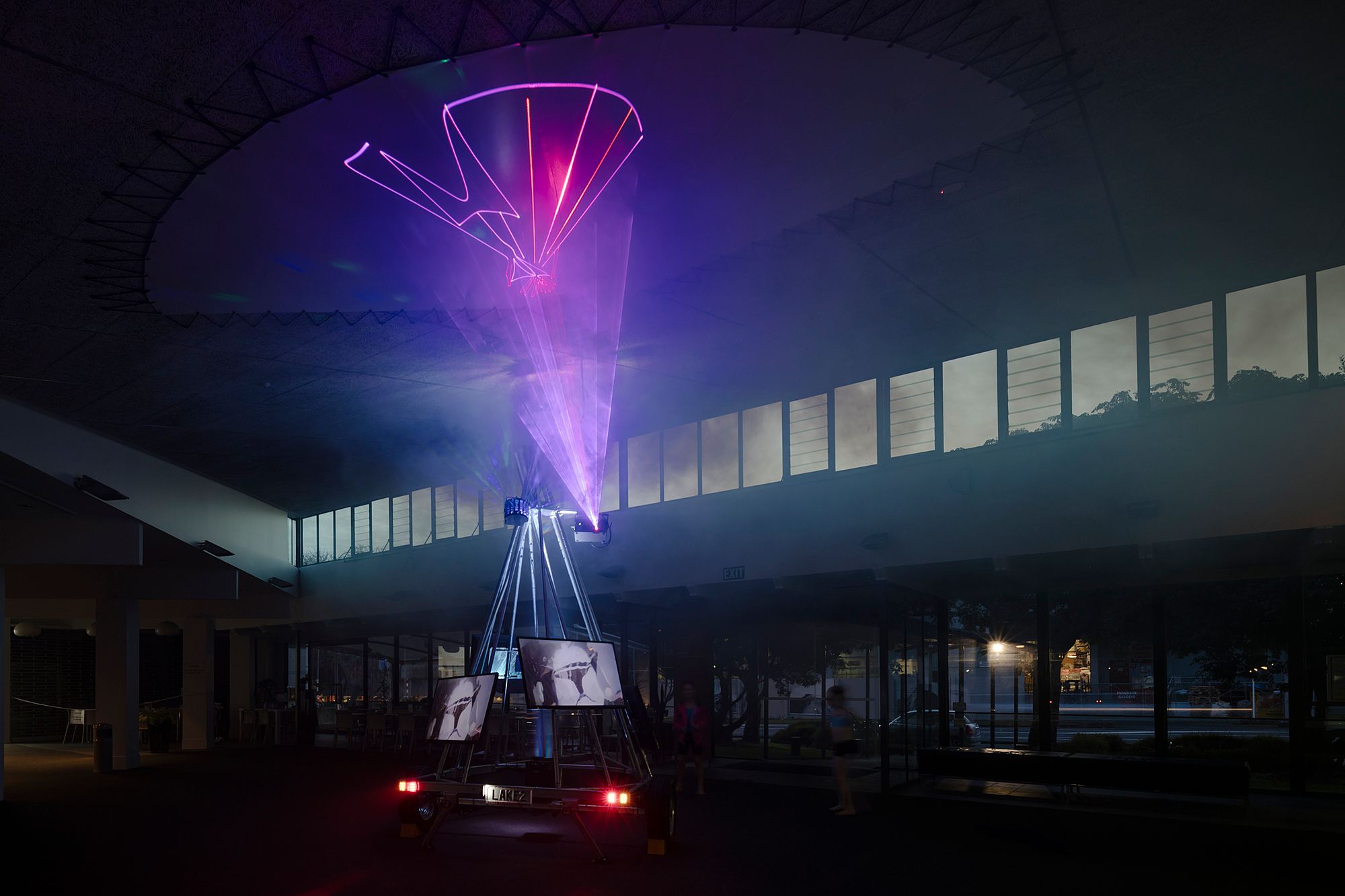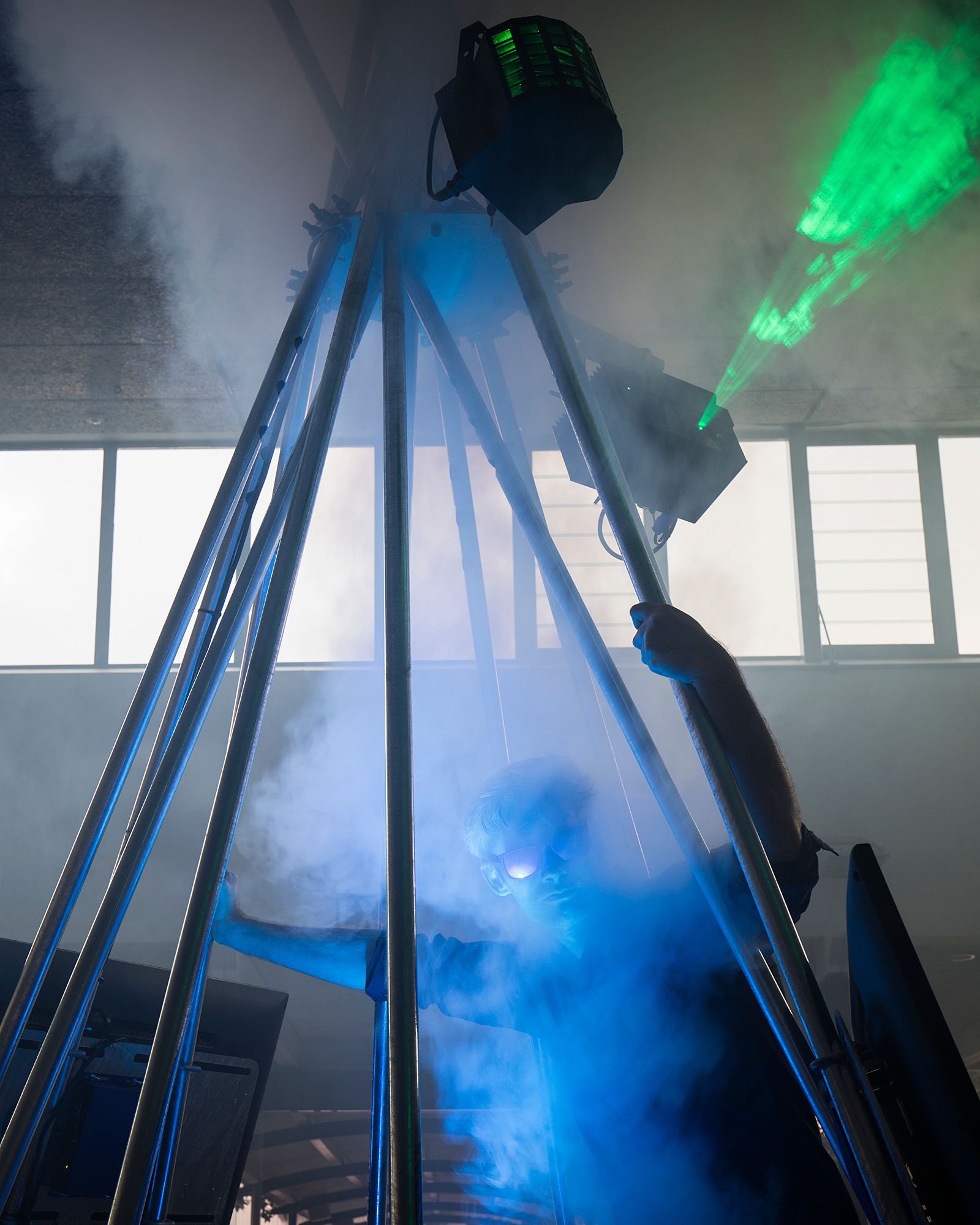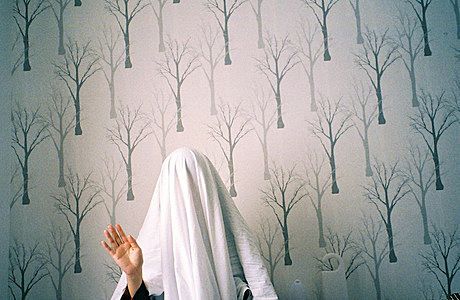A Little Bit Different: Considering Eddie Clemens' 'Clone Cities'
Jessica Douglas on Rotorua, nationhood, 'Star Wars', and a tipi on a trailer.
Jessica Douglas on Rotorua, nationhood, Star Wars, and a tipi on a trailer.
Picture, if you will, a trailer, on which stands an enormous metallic tipi, similar in appearance to Regan Gentry’s well-known sculpture, Flour Power (2008), in Christchurch. On the sides of the tipi are four screens that play a looped video. On the ceiling is a large canvas, which seems to have been stitched into place, and dancing across this are images projected by laser beam. Now add to this entire structure flashing lights and smoke. What you have conjured in your mind is Eddie Clemens’ Clone Cities, which sits in the middle of the foyer of Te Tuhi, Pakuranga, demanding attention.
Clemens is from Rotorua, which becomes clear straight off the bat. The installation’s smoke immediately recalls the city’s famous steam billows and geysers. Along the bottom border of the trailer’s number plate appears the name “Te Arawa”, the iwi associated with the Rotorua area. The plate is encircled with kōwhaiwhai patterns, situating the artwork firmly in the context of New Zealand. The number plate itself reads “Lake2”, a literal translation of Rotorua – roto being ‘lake’ in te reo Māori, rua being ‘two’.
Rotorua’s reputation is a mixed bag. On the one hand, it’s often dismissed as a tourist trap, with overpriced and underwhelming attractions. It’s ‘Rotovegas’: a shabby, provincial town full of accommodation that no one really wants to use. On the other hand, it’s something of a success story in terms of biculturalism. Māori play a prominent part in the city, and it’s a place where tikanga is actually celebrated. With all the theatrical light and smoke, is Clemens sending up his hometown? Or is he suggesting that Rotorua deserves a little more attention than it typically receives? It’s not immediately clear.
In the video, Clemens explores the phenomenon of ‘sister’ cities, visiting those associated with Rotorua: Lake Macquarie, New South Wales, in Australia; Beppu, on the island of Kyūshū, in Japan; the Wuzhong District of Suzhou City, Jiangsu Province, in China; and Klamath Falls, Oregon, in the United States. Like Rotorua, its sisters are cities without significant international profiles; they’re largely unimportant to anyone besides their inhabitants.
Like Rotorua, its sisters are cities without significant international profiles; they’re largely unimportant to anyone besides their inhabitants.
Sister cities in general are irrelevant to the majority of us most of the time (before seeing this installation, I didn’t even know they were a thing). There’s something quaintly idealistic about the phenomenon, as if designating twin cities might actually help foster world peace. And yet Clemens’ work suggests that they do represent opportunities to connect with people and cultures in other parts of the world, and that they can be instructive. By exploring them, Clemens demonstrates that we share many things in common with other places and people.
In the video, Clemens shows us a tap dripping water on soggy leaves, then cuts to a sign discussing water conservation in Oregon. And so New Zealanders are not alone in wasting water. The camera drops in on the meeting of a tribal council, while the soundtrack from an infomercial for doors that will “change your life” plays over the top. And so New Zealanders are not alone in negotiating the complexities of colonisation and commercialism. In one sister city, Clemens follows the instructions of a GPS: “In one hundred feet, turn right.” And so New Zealanders are not alone in blindly adhering to the ‘expertise’ of technology.
Like Rotorua, other cities have ceremonies that speak of tradition, enjoy their geological and geothermal quirks, are home to shepherding tour guides, and play host to garish carnivals. Although the video initially comes across as disjointed, on closer inspection it reveals itself to be a coherent exploration of sameness. The upshot is that although most of our tourism videos play up New Zealand as different and special, we are anything but. Much about our sense of self is kind of fraudulent.
*
I recently finished binge-watching the latest season of House of Cards, and the final episode really got me thinking about the United States and how proud its citizens are to call themselves Americans. In one of the last scenes, President Frank Underwood addresses the country in a broadcast in which he says, among other things, “God bless America.”
For me, this statement always conjures up the image of the US public standing together triumphantly as one united nation, singing their anthem (though perhaps I have simply watched too many American films). By encouraging its citizens to sing loudly while standing tall and holding their fisted right hands across their hearts, US politicians are doing their best to peddle their nation as sui generis.
We New Zealanders are also proud of our (‘100% pure’) country and our (less pure) history. We’re proud of our clean air, our Instagram-worthy landscapes, our good coffee, our robust healthcare system, our belief in the right to good education, the prowess of the All Blacks, and the list goes on … But Clone Cities has really got me thinking about national identity and whether it’s something we should be a bit more sceptical of.
Governments have been attempting to construct shared senses of identity since, well, the beginning of time. By emphasising ideas like tradition and national spirit, they’ve attempted to generate collective values or beliefs. While this has often been good for the governed, promoting internal harmony, it has also been used to further the sometimes questionable agendas of the state and its leaders. You don’t have to go far to find scary examples.
And it’s hardly a surprise. Because what, ultimately, does promoting tradition achieve? It defines the present and bestows institutions with legitimacy and authority. As citizens of the United States sing ‘The Star Spangled Banner’, a oneness is being constructed that can be used to advance the interests of people who do not deserve the singers’ loyalty, and to undermine the interests of people who do not deserve their hostility.
In his book Building Europe: The Cultural Politics of European Integration, University of Auckland Professor Cris Shore explores these matters further, discussing the creation of the European Economic Community and the forged invention of a pan-European tradition. Europeans were seen as lacking sufficient consciousness of their European heritage and identity and the European Commission intended to remedy this. It recommended various ‘symbolic measures’ for enhancing the Community’s profile. Foremost among these was the creation of a new EC emblem and flag.[1]
Although I’m sure we’re all sick of talking about flags, it’s an important topic. New Zealand’s recent referendum resulted in sticking with our current flag, adopted in 1902. Advocates of the rejected Silver Fern/Southern Cross flag spoke of the advantages of forging a united, national identity, and developing a fresh New Zealand consciousness, rather than one tied to our colonial past. Policy makers seemed to believe that social cohesion would flow from the emblem.
The artist critiques the New Zealand ‘brand’ in his artwork, hinting that national identity is part of social engineering, and that we shouldn’t blindly believe in any of it.
I do not know what Clemens’ position was on the flag, but, to me, his work serves to negate the idea of the nation in the 21st century, denying the use of identity as a tool for influence. The artist critiques the New Zealand ‘brand’ in his artwork, hinting that national identity is part of social engineering, and that we shouldn’t blindly believe in any of it. By scrutinising New Zealand from the inside and outside, he gives us an idea of what a more ‘Kiwi’ Aotearoa would look like: emulated, fake, and lacking in meaning.
I like what Clemens is getting at. We may be one nation but we certainly don’t believe that our culture is static or necessarily singular; we are multicultural, pluralistic. New Zealand and New Zealand-ness can’t be designed like a logo.
*
The actor Temuera Morrison – who is also from Rotorua – briefly appears on Clemens’ screens. Morrison played Jango Fett in Star Wars: Episode II – Attack of the Clones (2002), and he was the model for the clone troopers in Star Wars: Episode III – Revenge of the Sith (2005). In the video, Clemens opens a cardboard box, in which rests a Stormtrooper outfit. He proceeds to wear the suit in a number of different locations and at one point even asks a man, “Are you a fan of Star Wars?” (The man’s reply is nonchalant.)
What is Clemens getting at with this? On the one hand, the artist’s shenanigans suggest a straightforward enthusiasm for Star Wars. But there’s more going on. Clemens is also exploring pop culture and its potential problems. Like nationalism and invented tradition, pop culture bombards us with images and trends, and advocates a singular way of thinking.
Of course pop culture isn’t all bad – and Clemens reminds us of this with the light-hearted aspects of his work. However, it has changed a lot over time, deepening its influence. Pop culture is not merely dress-ups, it’s officially branded, factory-made novelty costumes shipped to your door. It showers our television, computer, and smartphone screens. As a result, people try to define themselves by, and even to mimic, the larger-than-life personalities they watch (the Kardashians/Jenners come to mind).
The idea of mediated, synchronised behaviour is further echoed in Clemens’ installation. Lights flash in time with the videos. The laser images projected on to the ceiling are controlled by a software system, much as a GPS navigates us through unknown locations. The installation’s seemingly random smoke is emitted by Te Tuhi’s front of house staff. No doubt this saves on waste, but it also nods at the question of authority/control and the illusion of technology as a guide.
A number of the laser-projected images are reminiscent of space, Star Wars, video games, and ’80s music videos. As a child of the ’90s, they remind me of the abstract shapes that would form while listening to music through Windows Media Player. The fonts used to spell out the different sister cities’ names recall my time at primary school, when I would choose 3D typefaces for title pages on the computer. I’m acutely aware of how nostalgia feeds into the construction of identity.
The video doesn’t appear to have a particular beginning or end. Like a dream, it starts somewhere you can’t quite recall.
A statement about excess and materialism (concepts which seem to go hand-in-hand with pop culture) also finds its way into the installation. While there are four TVs attached to the tipi, they play the exact same footage at the exact same time. The video doesn’t appear to have a particular beginning or end. Like a dream, it starts somewhere you can’t quite recall, throwing up abstract questions. When did we become so dependent on technology? When did New Zealand start to think of itself as a nation, against other nations?
To kids and cursory viewers, Clone Cities will be entertainment, and a lot of fun as such. But those who take a closer look will find that the installation grapples with issues that are relevant and affecting. Every day, we are subjected to dubious influences, many of which go unnoticed, though they stare us in the face. Ultimately, Clemens suggests, we might all be clones. Perhaps, in some respects, that’s okay. We are all human after all; we’ve a lot in common. But maybe, just maybe, we could do it all a little bit differently.
Clone Cities
Te Tuhi
26 May to 2 July 2016
Free admission
[1] Cris Shore, Building Europe: The Cultural Politics of European Integration (London/New York: Routledge, 2002), 47.





